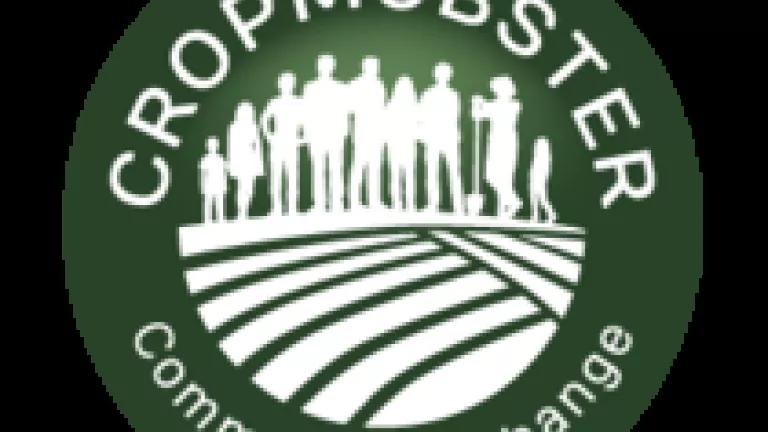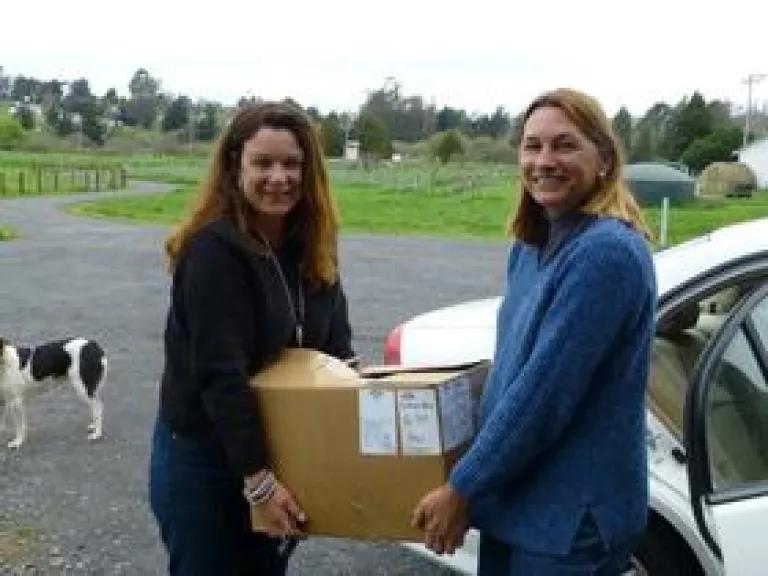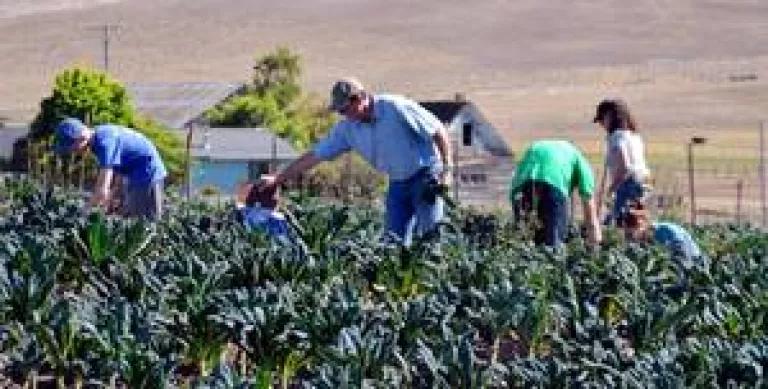
This is a guest post from Nick Papadopoulos, CEO and Co-founder of CropMobster and also the General Manager for Bloomfield Farms in Sonoma County, CA. Working on a farm, Nick gives us great perspective into how tools like his can help avoid waste while benefiting farmers.
At our family’s Bloomfield Farms it’s a straight up punch in the gut to watch boxes of perfectly edible broccoli, cabbage and other veggies return unsold from a farmers market. It’s frustrating to till under acres of slightly-blemished (and therefore unsellable) tomatoes or kale knowing that this produce should have been sold or donated in a perfect world. And this is just our perspective as folks working the dirt! From another angle, consider the parent or fixed-income senior struggling to put fresh veggies on the table combined with the knowledge that incredibly, over 50% of US fruit and vegetable production is wasted!
This is the frustration that gave rise to CropMobster, an online exchange and instant alert service. The idea was simple. What if we built a website where anyone with surplus food could publish alerts online? And what if these alerts could be broadcasted via social media to reach community members, small businesses and hunger relief groups? Could something like this help? Well, seven months in, the answer for our team at CropMobster is a definitive “you betcha!”
WHY THE SURPLUS ON OUR FARM?
As the NRDC and others have assessed, food loss and waste occurs for many reasons. For a small farm like ours here are a few we see. A kale crop might “go to seed” due to unseasonably warm weather. When this occurs we need to plow it under and replant ASAP to get back on track with production. In other situations some of our tomatoes might be blemished or the carrots a bit contorted, rendering them in both cases unsellable. There was also a situation last year when we had 40 boxes of organic broccoli that had started to yellow just a bit due to the heat. Despite 4 hours on the phone trying to find a hunger relief group we could only find a home for 8 boxes. The other 32 went to the compost.
At other times it has to do with planning and forecasting. We’ve had more than a few situations where we’ve produced a great crop - dry farmed potatoes for example - only to have a hard time selling out. And when it comes to farmers markets it’s difficult to know how much to harvest, pack and sell.
Overall, from my angle, it boils down to how hard it is for a small farm to perfectly plan and match supply and demand - especially when Mother Nature’s on the team and a good number of folks still have a hard time looking eye-to-eye with an ugly carrot.
HOW DOES CROPMOBSTER WORK?
CropMobster provides anyone with food surplus the ability to publish online alerts that are broadcasted via email and social media to individuals, hunger relief groups and small businesses. It could be a farmer offering a deal on tomatoes, a grocer such as Bi-Rite Market posting a donation on salad, salsa and milk or a non-profit organization like Marin Organic sharing a potato gleaning alert. And each week new innovative uses for our platform are emerging. For instance a syrup maker recently posted an alert on their organic food waste stream, in the hopes that it could become chow for some rancher’s hungry pigs.

WHAT ARE THE RESULTS WE’VE SEEN?
The CropMobster Community Exchange currently has about 4,000 participants, most in the greater SF Bay Area. About 100+ small farms and food businesses have published alerts. We’ve helped find a home for over 100,000 pounds of food, not including livestock, distressed plant starts and other materials. Atleast $50,000 in new revenue has been put in the bank accounts of local producers along with tax benefits associated with food donations. The vast majority (about 90%) of the alerts published on CropMobster have been taken. And once those alerts are taken we try as much as possible to distribute impact stories to make sure the community knows they’ve made a difference as a team.
WHAT HASN’T WORKED SO WELL?
As important as the successes it’s important to look at the situations that haven’t worked out so well. Below are a few of these examples that are informing our work to learn and innovate.
Larger offers are definitely harder to handle. In one instance early on we had a distributor of produce publish a deal on an entire ton of over-ripe (and therefore unsellable) grapefruit. At the end of the day, while the distributor got a number of smaller inquiries, no one had interest in taking the entire load. We were asked nicely to take down the post because it was (we think) becoming a waste of their valuable time as a business.
Crowd Sourcing Requires a Crowd. We learned this just as we’d made the decision to allow anyone in Yolo County to use CropMobster. A peach farmer posted a deal on 4 acres of unsold and unharvested peaches. They’d had a rough go of things in the sales department. But despite all our best efforts we didn’t have enough CropMobsters in the Yolo area to help. We were informed that while the alert generated a few good customers CropMobster did not deliver the interest level needed to save all the peaches.
Moving Things “The Last Mile” Can Be Tough. Lastly, sometimes demand exists but there’s a pick-up and delivery challenge. For instance, a local olive oil producer posted two 55 gallon drums of organic olive oil. While there was a good deal of interest none of the potential customers had the ability or equipment to haul and unload the olive oil. It was just too heavy.

ONWARD & LET’S GIT-R-DONE!
CropMobster started on one farm to solve one problem in one community. And fairly quickly we’ve grown to reach 12 counties in the greater SF Bay Area. Based on our experience and learnings we are absolutely certain that we can be one of the many innovations unleashed to tackle the food waste crisis around the world.
But beyond the CropMobster model or technology there’s something more important to convey. And it has to do with mindset. Don’t believe for one second that the food waste crisis is intractable or unsolvable because it’s not – actually it’s transformable. Hopefully the story of the CropMobster community has helped illustrate this potential. Let’s Git-R-Done. Onward!
About Nick Papadopoulos:
Nick Papadopoulos has spent the greater part of two decades as a business management consultant and community facilitator on public policy issues. In 2012 he took a rewarding “detour” to serve as GM of Bloomfield Farms, his family’s 50 acre organic vegetable farm in Sonoma County, California. It was during this experience that he and his wife Jess Flood saw first-hand the food waste problem and teamed with Gary and Joanna Cedar of PressTree to launch the CropMobster community exchange and social venture.
Photo Credits: Nick Papadopoulos and Gary Cedar
